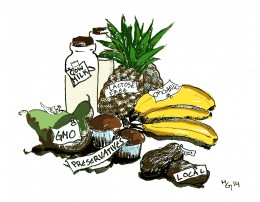
Sodexo’s contract is up for renewal at the end of next year, which means it’s time for us students to tell Binghamton University what we want out of the company that feeds us. On Thursday afternoon, five student groups gathered in the lobby of the Glenn G. Bartle Library to rally student support for changes to the University’s dining policy. These students believe now is the time to advocate for shifts toward more sustainable, humane dining options. Their requests are reasonable, and should be heeded as negotiations with Sodexo — and other food providers — move forward.
The groups are circulating a petition urging Sodexo and BU to sign the Real Food Challenge (RFC), a set of provisions developed by the national organization of the same name. If Sodexo were to sign the RFC, by 2020, 20 percent of dining hall food would have to meet at least one of the four RFC conditions. The conditions are feasible: The food would have to be sourced locally and ecologically as well as be raised in an ethically sound way, and it would have to be produced with the humane treatment of workers and products. This is a “20 by 2020” plan we can actually get behind. It’s a low bar, and Sodexo should be able to meet it.
Another idea that students proposed is that Sodexo label which products use GMOs, which would allow students to make more informed decisions and be aware of what they consume. But as far as labeling goes, it would be more helpful if Sodexo provides the list of ingredients in all its dishes.
Including ingredients on packaged products and prepared foods is no luxury: It should be the standard. There’s no reason why students should need to go through hoops to figure out what exactly is in their food, particularly for students who are diabetic or have sensitive food allergies. Diets and restrictions are not new, but their prevalence has increased. More people than ever follow vegetarian, vegan, kosher and gluten-free dietary rules. With so few indicators on the options the dining hall makes available, and with many employees unsure of all the ingredients, this sensitive information is unavailable to students with food restrictions. Of course, one may always call the campus dietician, but labels including a full list of ingredients as well as sources is a much easier fix than making a phone call to the single dietician serving over 13,000 students.
Of course, making these changes isn’t easy. They require overcoming numerous logistical challenges, and that takes time. But it’s also more important than ever to understand what’s in our food, where it comes from and how it’s made, and this is a promising way to start.


